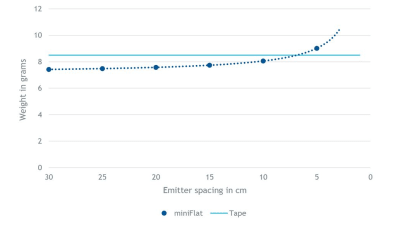Get more from drippers. Extrusion lines for thin wall irrigation laterals with flat emitters

Users of micro-drip irrigation for seasonal crops look towards the most economical thin wall laterals available. Two types fall into this category – continuous tape and miniFlat drippers. With the latest innovations on PIL 032-miniFT//Explore extrusion lines, miniFlat is competitive with dripper spacing of 10 cm and above.
Plastic only where needed
A miniFlat dripper (emitter) is qualified by its size and the volume of plastic employed. Indeed, the miniFlat is roughly 50% smaller in size compared to the classic micro-drip emitter. The advantage of less plastic is essential when compared with tape.
Another consideration is the drip spacing capability. The tape product can be thought of as a continuous emitter strip with pools spaced at regular intervals, usually about 10 cm (4"). It is then a multiple of pool spacing that determines drip locations and where holes can be made. As a result, drip distance for tape cannot be anything but a multiple of emitter pool spacing (e.g. 4", 8", 12", etc.). On the other hand, MiniFlat offers a full range of emitter spacing possibilities, from 10 cm and above.
With tape, the strip is continuous and without interruption along the lateral's entire length. The amount of plastic is independent to the drip locations. To the contrary, miniFlat's use of plastic is variable, and is dependent to the drip locations. A larger space between emitter points means less plastic required per meter.
The two criteria of emitter volume and spacing combine to determine the material required according to product type. Knowing the volume of plastic required between emitter points, indicates how well miniFlat and tape products match up.
Read the complete article >>>
- Tube machinery •
- Machines for electric cables and optical fibers •
- Other machines for cables and optical fibers •
- Taping machines


